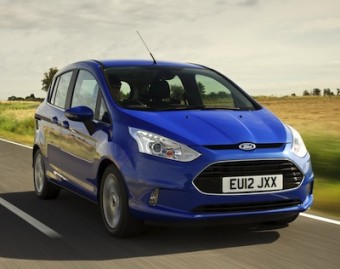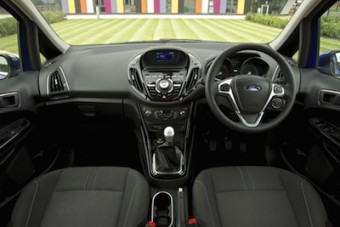 The first of the new Ford B-Max compact people carrier or multi activity models, with clever rear side sliding doors for very easy ingress and egress, are already in the hands of a 1,000 UK customers.
The first of the new Ford B-Max compact people carrier or multi activity models, with clever rear side sliding doors for very easy ingress and egress, are already in the hands of a 1,000 UK customers.
Close to 3,000 vehicles are already ordered out of an annual UK sales target of 16,000 units.
Priced from an attractive £12,900 to a less appealing £18,895, the clever B-Max is based on the Fiesta platform and replaces the previous Fusion mini MPV.
In addition to the normal array of four cylinder petrol and diesel 1.4 to 1.6-litre engines, the B-Max range uses the award winning
new generation 1.0-litre three-cylinder turbocharged petrol engine with two levels of power output, the best selling 100PS unit and the 120PS version.
There is the choice of the base level Studio, the best selling Zetec and the top spec Titanium levels of specification, depending on which engine is chosen. For those drivers that have the need for an automatic transmission this is available with the 1.6-litre, 105PS petrol engine.
The main feature of this new model is the easy-in, easy-out four door system supported by the wide opening rear tailgate.
The B-Max design with hinged front doors and sliding rear side doors does away with the conventional fixed B-pillar between front and rear hinged doors. This design allows for 1,500mm wide and easy access through the side doors, great for loading people or long loads.
A conventional B-segment car has door openings of only 700 to 800mm. With the rear sliding doors in particular, getting in or out of the vehicle in today’s cramped side-by-side parking spaces is very easy. With the upright higher positioned seats loading children is much easier and people with mobility issues will find it much easier to get in and out of the vehicle as well. With a relatively low waistline and high roofline allowing for deep windows visibility from inside the vehicle is first class in all directions.
With seating for four adults or two adults and up to three children there is 318-litres of boot space but fold down the rear seats to reveal a completely flat load floor and the load capacity goes up to 1,386-litres, or 304 and 1,372-litres if the £95 mini spare wheel option is taken. Fold down the front passenger seat and the load length for long items is 2.3-metres.
 The move away from having B-pillars has not stopped the B-Max gaining the all-important NCAP five star safety rating as the frames of both doors and the interlocking sections of the B-pillars incorporated in the doors are all manufactured from high strength steel.
The move away from having B-pillars has not stopped the B-Max gaining the all-important NCAP five star safety rating as the frames of both doors and the interlocking sections of the B-pillars incorporated in the doors are all manufactured from high strength steel.
Once the doors are locked in the closed position the torsional strength and integrity of the vehicle is preserved and the handling remains as taught and as sharp as the Fiesta hatchbacks.
An untidy detail with the design and its application is the electric cable flexible trunking leading from the main bodyshell of the car to the bottom of the sliding doors. This trunking carries the electric cables for the windows and central door locking and is exposed when the door is open. It looks a cheap solution and potentially it might be snagged by feet or items being loaded or unloaded.
 The front interior design and ergonomics of the instruments and controls are very much the same as the Fiesta. Specification for the base Studio version includes electrically operated front and rear windows and door mirrors, central locking, radio/CD player, front, side and curtain airbags, 15-inch steel wheels with covers, Easy-Fuel capless refuelling function, daytime running lights, electronic stability programme and ISOFIX child seat mounting points. No B pillar gives exceptional rear access
The front interior design and ergonomics of the instruments and controls are very much the same as the Fiesta. Specification for the base Studio version includes electrically operated front and rear windows and door mirrors, central locking, radio/CD player, front, side and curtain airbags, 15-inch steel wheels with covers, Easy-Fuel capless refuelling function, daytime running lights, electronic stability programme and ISOFIX child seat mounting points. No B pillar gives exceptional rear access
The Studio specification is only available with the 1.4-litre, 90PS, four cylinder petrol engine. It’s a bit tardy for performance but has a top speed of 106mph, a zero to 62mph takes13.8-seconds and will return officially 47.1mpg but 39.3mpg on my 70mph motorway test drive. With CO2 emissions of 139g/km road tax is £120. But the big advantage of this B-Max version is its purchase price, a very attractive £12,995.
For UK customers on a budget this model makes most economical sense. The saving in purchase price this model offers can buy lots of fuel and easily covers the more expensive road tax compared to the much publicised 1.0-litre petrol three cylinder EcoBoost unit.
The B-Max with the 1.0-litre EcoBoost three cylinder 100PS petrol engine with Zetec specification is expected to be the best selling model but it costs £16,195. Unfortunately this engine is not available with the cheaper Studio spec.
This unit officially returns 55.4mpg and my country roads test drive resulted in a real-life figure of 43.5mpg.
Top speed is 109mph and zero to 62mph takes 13.2 seconds. The CO2 emissions means VED road tax is £0 for the First Year rate then £30 for the second year onwards. The distinctive throaty sounding three-pot engine with its turbo boost is flexible at low speeds and responsive to drive but in fact is not really much quicker than the cheaper to buy four cylinder 1.4-litre petrol engine.
Zetec specification includes additions over the Studio level such as 15-inch alloy wheels, brightwork trim finishes inside and out, front fog lights, heated windscreen, air conditioning, leather trimmed steering wheel, extra interior lighting functions and a trip and fuel computer.
Ford’s SYNC system for Bluetooth and connecting mobile phones and music players also reads text messages and in the event of an accident automatically connects to the emergency services and provides a GPS location.
It is fitted as standard to the Titanium models and is available as a £250 option for Studio and Zetec versions.
I also had a quick outing in the 1.6-litre TDCi 95PS turbodiesel powered B-Max priced at £18,895 and only available with the top Titanium specification. This model makes no financial sense for retail customers and only high mileage business or fleet buyers might choose this version.
 The CO2 emissions are 104g/km so VED road tax is £0 First Year and then £20 each year after that. Officially this engine will return 70.6mpg, (51.3mpg on my test drive). Top speed is 108mph and zero to 62mph takes 13.9 seconds.
The CO2 emissions are 104g/km so VED road tax is £0 First Year and then £20 each year after that. Officially this engine will return 70.6mpg, (51.3mpg on my test drive). Top speed is 108mph and zero to 62mph takes 13.9 seconds.
Interestingly, the heavier the engines were the better and less choppy the ride of the B-Max was over our poor and rippled road surfaces.
The lightweight 1.0-litre petrol unit was the least composed, the 1.4-litre petrol unit was better and the 1.6-litre TDCi diesel better still. It appears that unlike most other manufactures, Ford under their ‘One Ford’ global vehicle policy do not make specification changes such as suspension settings for each country, so we get the World universal settings which is not ideal.
VERDICT
In short the compact Ford B-Max people carrier offers a lot in terms of people carrying and load space.
Available with a wide choice of engine options today’s financially hard pressed motorists must be clear on which version suits them best and in particular which suits their motoring budget best.
Sometimes less specification and a less technically advanced engine is more appropriate, so I would suggest the 1.4-litre petrol Studio version could be a better buy and a bit of a bargain for some families at £12,995.
MILESTONES
Ford B-Max 1.0-litre EcoBoost 100PS Zetec 5-Door. (Ford’s predicted best selling UK model). Price: £16,195. Engine/transmission: 1.0-litre, three cylinder, direct injection, variable cam timing, turbocharged petrol, 100PS (99bhp), 170Nm (88lb ft) from 1,400rpm, 5-speed manual gearbox.
Performance: 109mph, 0-62mph 13.2 seconds, 55.4mpg Combined Cycle (43.5mpg on test), CO2 119g/km, VED road tax £0 First Year rate then £30 per annum.
Insurance group: 10 (TBC).
Warranty: 3-Years/60,000 miles. Dimensions/capacities: L 4,077mm, W 1,751mm, H 1,604mm, boot/load space 318 to 1,386-litres.
For: Good to drive, practical to use, easy loading/unloading of passengers and luggage, nimble handling, easy to park, good visibility.
Against: Diesel models make no financial sense for most retail customers, untidy wiring loom, top models expensive and no tuned suspension settings for UK roads

